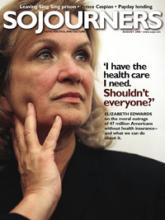Wind across the quay-side / Grit in my eyes and fish in my nose / White as whalebone, wheeling seagulls cry.
—from “Never So Free,” by Bruce Cockburn
The gospel of Matthew is alive with fish: Nets are filled with them (Matthew 13:47), fishers are called to catch human beings (Matthew 4:18-19), and a crowd is fed on a few loaves and fishes (Matthew 14:17-20). According to biblical historian K.C. Hanson, “because Jesus made his residence in the fishing village of Capernaum during his ministry and traveled up, down, and across the Sea of Galilee, the lives of these real fishing families became the fabric from which he wove many of his metaphors and told his stories.”
This month the gospel readings from Matthew 14-16 are drawn from the stark realities of this family-based fishing economy and its encounter with Rome.
Near Capernaum, three miracles—a feeding, a sea rescue, and a healing and restoration—remind us that even today the very poor are the people who are most harmed by famine and hunger, disease and disability, and storms and natural disasters.
In quite different ways, the feeding story and Jesus’ encounter with a Canaanite woman highlight the importance of women, surplus food, and children. And although we find a complex and detailed portrait of the fisherman Peter, in Matthew it is not the known insiders but nameless women who represent the model of faithfulness.
August 3
Not Counting Women and Children
Genesis 32:22-31; Psalm 17:1-7, 15; Romans 9:1-5; Matthew 14:13-21
Beside the Sea of Galilee, a crowd is fed on a few loaves and fishes (Matthew 14:16-21). According to the New English Translation, about 5,000 ate, “not counting women and children.” But bad things happen when women and children aren’t counted, and fish are not always a sign of abundance.
Read the Full Article
